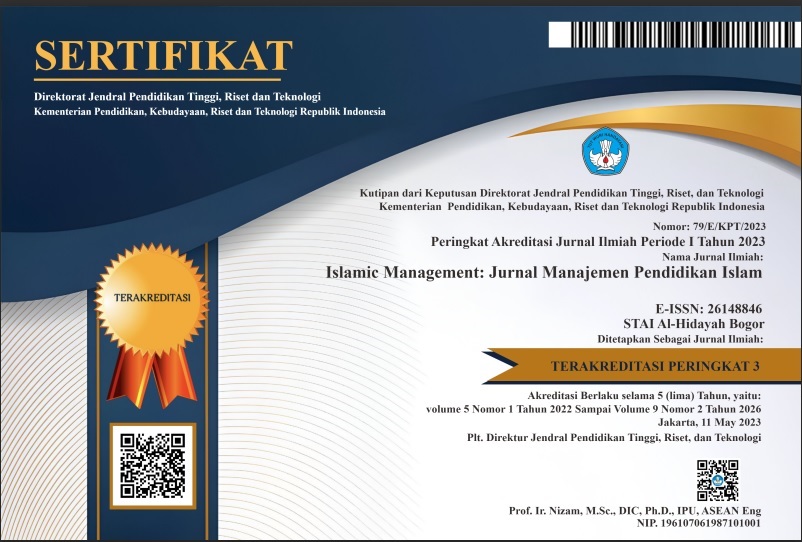UTILIZATION OF MISCROSOFT POWERPOINT MEDIA IN ISLAMIC AGE EDUCATION LEARNING AT MTS NEGERI 1 SURAKARTA
DOI:
https://doi.org/10.30868/im.v8i01.8382Keywords:
Media Utilization, Microsoft Powerpoint, Islamic Religious EducationAbstract
This research discusses the utilization of Microsoft PowerPoint media in learning Islamic Religious Education (PAI) at MTs Negeri 1 Surakarta in the era of Industrial Revolution 4.0 and society 5.0. Rapidly developing information technology demands innovation in learning methods, including the use of digital media such as PowerPoint. The results showed that the use of PowerPoint facilitates the delivery of the material, increases student enthusiasm, and supports learning effectiveness. However, obstacles include high license fees and training needs for teachers. In conclusion, PowerPoint is an effective learning medium in supporting Islamic education objectives, subject to the challenges.
References
Achmad, Ghufran Hasyim, Lahmuddin Lubis, and Wina Asry. 2020. “Ilmu Pendidikan Islam Pengembangan.” Bumi Aksara, 3 (6): 4329–39. https://doi.org/10.31004/edukatif.v3i6.1319.
Davis, Fred D. 1989. “Perceived Usefulness, Perceived Ease of Use, and User Acceptance of Information Technology.” MIS Quarterly: Management Information Systems 13 (3). https://doi.org/10.2307/249008.
Esih, Kurniaty. 2020. “Pemanfaatan Media PowerPoint Sebagai Media Pembelajaran.” Ayo Guru Berbagi. 2020.
jdih.kemendikbud.go.id. 2003. “UNDANG-UNDANG REPUBLIK INDONESIA NOMOR 20 TAHUN 2003 TENTANG SISTEM PENDIDIKAN NASIONAL DENGAN RAHMAT TUHAN YANG MAHA ESA PRESIDEN REPUBLIK INDONESIA.” Jdih.Kemendikbud.Go.Id. 2003.
Kurniaty, Esih. 2020. “Pemanfaatan Media Power Point Sebagai Media Pembelajaran.” Diunduh Dari Laman Https://Ayoguruberbagi. Kemdikbud. Go. Id/Arti Kel/Pemanfaatan-Media-Powerpointsebagai-Media-Pembelajaran. 2020.
Muhaimin. 2020. Paradigma Pendidikan Islam. PT Remaja Rosdakarya.
Nastiti, Faulinda Ely, Aghni Rizqi Ni’mal ’abdu, and Jurnal Kajian. 2022. “Kesiapan Pendidikan Indonesia Menghadapi Era Society 5.0.” Edcomtech 5 (1): 61–66.
Parwati, Ni Putu Yuniarika, and I Nyoman Bayu Pramartha. 2021. “Strategi Guru Sejarah Dalam Menghadapi Tantangan Pendidikan Indonesia Di Era Society 5.0.” WIDYADARI: Jurnal Pendidikan 22 (1): 143–58. https://doi.org/10.5281/zenodo.4661256.
Poerwadarminta. 2002. Kamus Umum Bahasa Indonesia. Jakarta: Balai Pustaka.
Rahmawati, M., E. A. Napitupulu, and A. D. D. Singgi. 2021. “Penyelenggaraan Kebijakan Aborsi Aman, Bermutu, Dan Bertanggung Jawab Sesuai Dengan UU Kesehatan Di Indonesia.” Institute for Criminal Justice Reform. http://scioteca.caf.com/bitstream/handle/123456789/1091/RED2017-Eng-8ene.pdf?sequence=12&isAllowed=y%0Ahttp://dx.doi.org/10.1016/j.regsciurbeco.2008.06.005%0Ahttps://www.researchgate.net/publication/305320484_SISTEM_PEMBETUNGAN_TERPUSAT_STRATEGI_MELESTARI.
Sari, Syti Mayang, Muhammad Riduan Harahap, and Ahmad Ridwan. 2023. “Pemanfaatan Media Pembelajaran Poster Dalam Upaya Meningkatkan Minat Belajar Siswa Pada Mata Pelajaran Fiqih.” Insiru PAI 7 (2).
Shabir, M, Usman Usman, and Kamal Kamal. 2023. “Pendidikan Agama Islam Di Sekolah Umum.” Indonesian Journal of Intellectual Publication 3 (1): 58–64. https://doi.org/10.51577/ijipublication.v3i1.384.
Thoha, Chabib, Saifuddin Zuhri, and Syamsudin Yahya. 2004. Metodologi Pengajaran Agama. Fakultas Tarbiyah IAIN Walisongo.
Trianto. 2007. Model Pembelajaran Terpadu Dalam Teori Dan Praktek. Jakarta: Prestasi Pustaka.
Umro, Jakaria. 2020. “TANTANGAN GURU PENDIDIKAN AGAMA ISLAM DALAM MENGHADAPI ERA SOCIETY 5.0” 5 (1): 79–95.
Yasmansyah, and Supratman Zakir. 2022. “Arah Baru Pendidikan Agama Islam Di Era Digitalisasi.” JKIP : Jurnal Kajian Ilmu Pendidikan 3 (1).
Downloads
Published
How to Cite
Issue
Section
Citation Check
License
Copyright (c) 2025 Ahmad Alamul Huda Kholadan, Nurul Latifatul Inayati

This work is licensed under a Creative Commons Attribution-ShareAlike 4.0 International License.
Authors who publish with this journal agree to the following terms:
- Authors retain copyright and grant the journal right of first publication with the work simultaneously licensed under a Creative Commons Attribution License that allows others to share the work with an acknowledgment of the work's authorship and initial publication in this journal.
- Authors are able to enter into separate, additional contractual arrangements for the non-exclusive distribution of the journal's published version of the work (e.g., post it to an institutional repository or publish it in a book), with an acknowledgment of its initial publication in this journal.
- Authors are permitted and encouraged to post their work online (e.g., in institutional repositories or on their website) prior to and during the submission process, as it can lead to productive exchanges, as well as earlier and greater citation of published work (See The Effect of Open Access).






